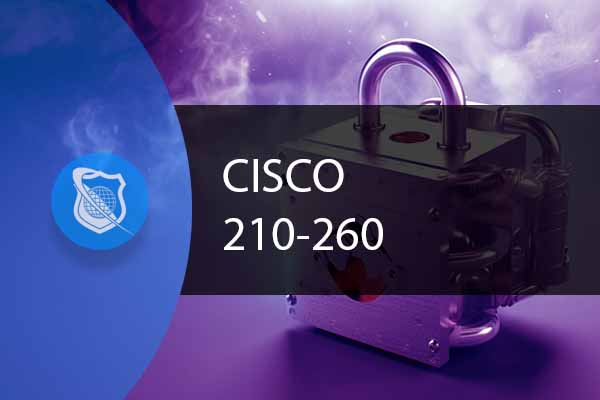$0.00
NO CREDIT CARD REQUIRED This IT course will teach you key concepts you need to know about Cisco’s security technologies, including how to install and troubleshoot network devices. By the end of the course, you’ll be able to confidently maintain data integrity and availability, and have a thorough understanding of Cisco’s security structure and be prepared to take the Cisco Certified Network Associate Security (Cisco CCNA Security) exam.

The Cisco IINS 210-260 CCNA Security course provides comprehensive training on Cisco’s key security technologies. The course is designed to equip you with the knowledge and skills to install, troubleshoot, and monitor network devices, ensuring data integrity and availability. Although the related exam has been retired, the course remains an invaluable resource for understanding Cisco’s security structure.
The course highlights core security technologies, common security threats, and mitigation strategies. It provides a thorough understanding of how to develop a security infrastructure, identify network vulnerabilities, and safeguard against web-based and endpoint threats. The course aims to build competence in the technologies that underpin Cisco’s security infrastructure1.
Note: To earn the Cisco CCNA Security certification, an official exam (210-260 IINS) must be passed. This exam tests knowledge in secure network infrastructure, secure access management, VPN encryption, firewalls, intrusion prevention, and web, email, and endpoint security.
Course Fee: The course, originally priced at $49.99, is now available for free. No credit card required to access the training.
The Cisco IINS 210-260 CCNA Security course on ITU Online covers key concepts about Cisco’s security technologies, including how to install and troubleshoot network devices. By the end of the course, students should be able to maintain data integrity and availability, understand Cisco’s security structure, and be prepared to take the Cisco Certified Network Associate Security (CCNA Security) exam.
The course consists of 13 training hours and 51 videos divided into 11 topics. There are also 251 practice questions available to help reinforce the learning material.
The Cisco CCNA Security certification exam, known as 210-260 IINS, tests your knowledge in secure network infrastructure, understanding core security concepts, managing secure access, VPN encryption, firewalls, intrusion prevention, web and email content security, and endpoint security.
The Cisco CCNA Security certification exam, also known as the Implementing Cisco Network Security (IINS) exam, is a 90-minute test.
The CCNA certification is highly recognized and popular in the IT industry. It can lead to job roles such as Junior Network Engineer and Senior IT Helpdesk with some amount of network support. It is also beneficial for employers. The CCNA certification is often a stepping stone to more advanced certifications such as CCNP and CCIE. Cisco’s certifications are considered valuable because a significant portion of the world’s networks and the internet run on Cisco gear.
While the course provides comprehensive training on Cisco security technologies, it’s important to note that the associated examination for this course has been retired. Therefore, while it remains a valuable training resource, it does not directly correspond to the current Cisco certification exams.
David has been a professional IT instructor for the past four years for the US Army. He teaches a broad range of certification courses ranging from CompTIA, Microsoft to Cisco and EC-Council. Prior to working with the US Army, David worked as a Jr. Network Admin and Web Services Manager with KCTCS in Kentucky. He performed multiple jobs being on the IT team. Additionally, David taught part-time during the evening at the college, where he instructed on Active Directory, Introduction to Computers, and Networking. David has 18 years of IT experience, 17 professional IT certifications, and 8 years of teaching experience.
Chris is a Sr. Cisco Instructor and leading consultant for clients throughout the U.S. Chris has over 15 years’ experience as a network engineer and 5 additional years as an instructor. Chris has worked at the service provider/partner level throughout his career, working with national and global clients to solve complex business problems through the use of technology and IT training solutions. Working with Chris, you will see a true industry expert with experience, drive, and patience unparalleled in the industry.
Chrys Thorsen is an education and technology expert who specializes in enterprise-level IT infrastructure consulting and certified training-of-trainers. In her career, she has garnered over 50 IT Certifications including CISSP, CISA, CEHv12, PenTest+, CompTIA CNVP, Cisco CCSI/CCNP, Microsoft Cloud and on-premises technologies, VMware vSphere, and many more. She has also authored 40 published certification textbooks, and over 35 full-length IT certification video courses.
When not working in the United States, Chrys spends her time abroad capacity-building IT literacy in developing nations in Sub-Saharan Africa. Her client list has included: the US Federal Government, the Republic of Zambia Ministry of Health, Cavendish University Zambia, Accenture, JP Morgan Chase, the US Centers for Disease Control and Prevention, the Elizabeth Glaser Pediatric AIDS Foundation (EGPAF), Hughes Aircraft, Microsoft, and many more.
Chrys lives by, and is fond of repeating, her professional creed:
“The only true measure of success for any project or training is results on the ground. Everything else is just noise.” “I teach what I deploy; I deploy what I teach.”
ENDING THIS WEEKEND: Train for LIFE at our lowest price. Buy once and never have to pay for IT Training Again.